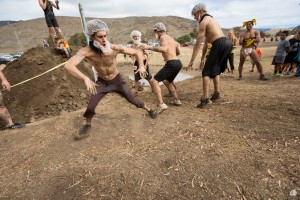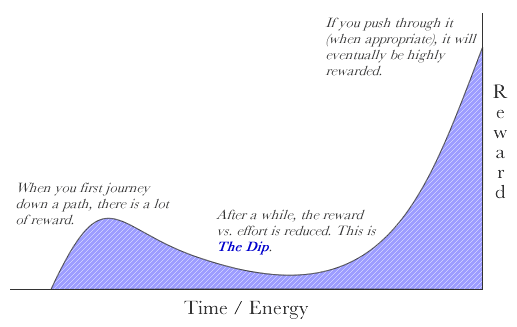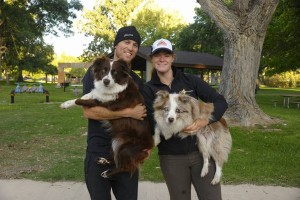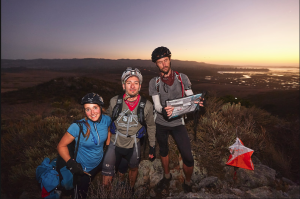We make it our business to know the ins and outs of our business, and that means that despite us not being the biggest on the block, or the most profitable, we are generally slightly ahead of event trends for a reason.
When we started doing this, we were eager kids with a lot of free time, not a lot of business acumen or long term vision, unlimited energy, and extremely limited income. We landed large sponsorships from recognizable companies, got a lot of local support, and made it feel like this was an easy place to make our way.
My, how things have changed!

The final Mud Mash, RIP little guy!
In 2010, we had a stable of ten events: adventure races, triathlon, runs, bike races, mud runs, and more. We worked hard, we played hard, and hopefully we made a lot of people happy. In 2016, we’ll be self producing two events. Why the shrink?
A number of factors, many of which affect the future of all events going forward:
- Insurance changes – As time has progressed, events have gotten larger as a whole and had more attention from the insurers themselves. Since land managers won’t let you produce an event on their property without it, insurance is a must. But when the requirements for insurance start to impinge on the ability to produce an event, it starts to become a problem. This could be required coverage increasing over 100% from one year to the next, it could be restrictions on an event’s features (aka, you can’t have water activities or obstacles), or it could be flat out refusal to insure, depending on the event. History, longevity, and safety records don’t matter.
- Politics and resource management crackdown – Whether it’s Florida or California, we’ve experienced more and more difficulty because of permit requirements from management agencies. We’ve had government agencies demand we hire a specific company in the permitting process for a service that charges way more than something any other company could provide, we’ve had safety agencies require above and beyond coverage because of one thing happen with a different event because of poor management and planning, and we’ve had increased demands for permits – requiring thousands of dollars of professional services we used to be able to do ourselves. Things like this limit creativity, and definitely limit profitability for an event. We’re proud of our professionalism and ability to navigate this world and make things work (our 24 hour race this year involved 14 different permitting agencies working in conjunction with one another in a location we’d never hosted an event at, and everyone left happy!), but that’s a benefit of over a decade of learning the game. The newer entries to the event world will have a harder and harder time, especially as we feel the squeeze.
-

It took a lot of convincing and team work to get this 24 hour adventure race to go.
Marketing Challenges – Ten years ago, we didn’t have quite the sophisticated marketing machine we do now. This is good and bad. You can target the heck out of people you think would like to know about your event, but unless you have the $$ to do so, you’ll never get through. An old advertising adage was you have to hit someone 7 times before they engage.
- How much will that cost? We particularly loved Spartan Race’s Joe Desena in an article with Obstacle Racing Media: “When Spartan was first beginning to advertise in 2010, DeSena said he had a “moment of insanity” and was spending about $300,000 a month on digital marketing. In what could have been a warning to potential competitors looking at the Obstacle Course Racing business, DeSena said if he were to attempt to reach that same amount of people today it would cost about eight times that $300,000 monthly expense. “It would be hard for us to recreate that today”.”
- In 2014, we went into $15,000 debt to throw everything we had at marketing our obstacle race and triathlon – and the result was what we expected: not enough. Fancy website redesigns, aggressive online targeting, and billboards just won’t do it. Without a built-in desire by the population to find your event, unless you’re an established something in your community, it’s a massive uphill battle that requires either patience or lots and lots of money. Neither of which is a guarantee of success.
- Community Support – We’re not talking about the racing community here. If you are putting on a good quality event, you’re touching your participants in a sincere and impressive way, and you’re relating to them on a peer level, you’re winning. The key here is getting enough of them. But, no, we’re talking about the larger community: local businesses, governments, and tourism boards getting behind what you’re trying to do. We’ve seen events have a LOT more success here than we by bringing a different game with them: while we’ve been putting on events *we* think are cool, the better tactic for support is finding out what the community wants and bringing that forth. This can be through demographic research, surveys, or asking. But, for us? We’d rather do what we love than do what others want us to.
- Big business/scalability/adaptability – With the advent of the Internet and social media, we’re very, very connected. The local mom and pop event won’t draw to its potential unless you go big. Just like chain businesses where a loss here and there balances out with a portfolio of locations, so too are the more successful event chains.
- At the same time, we’ve watched the rise and fall of attempts through the years, most notably the obstacle course races. Remember Zombie Runs? Man, when all the zombie movies came out, I was sold. But what was promised and what was delivered couldn’t line up. Beyond that, people moved on from zombies to the next trend. The undead are dead.
- Obstacle course races in general definitely peaked a few years ago. We had to compete with two other events locally one fall, both under delivering and blighting the offering as a whole. And, beyond that . . . only a few races have maintained viable numbers (though they are falling vastly from their peak years) from what we can see – and they did it by scaling big time right away, plugging in, digging deep, and expanding internationally. Only so many people have the investment and skill resources to make that work. Certainly not the majority of event producers, and to the detriment of why most get into it in the first place – to have fun!
- The other thing we’ve seen happen here is events that survive, adapt. Again, a great example of that has been The Spartan Race series: started in the heat of passion for the movie 300, thousands of people, inspired by the Greek Spartans signed up to test themselves. The original races focused heavily on the Spartan theme . . . but as the passion for 300 faded, they harnessed the passion for the workout it inspired, and the Crossfit revolution that started around the same time and created a symbiotic relationship there. It was brilliant, it was forward thinking, and it is something most of us lack the ability to do while mired in a million things at once. There are triathlons based on lakes are literally drying up and attendance is waning . . . adaptability is the #1 thing to do if you’re established but want success.
-

Just another triathlon, but an ocean one, with kayaking, and great community support.
Recognizing that the market is saturated – It is IMPOSSIBLE to schedule an event that doesn’t conflict with a compatible event. You have to either be so cool and different that they have to try yours, or you have to be more accessible in some way or another. And you have to make sure the population that wants to go to both is big enough to fill both.
Bottom line, the only way to make events work these days is figure out what people want, and give it to them. But then you also have to have the means to do so.
Some of our events have failed dismally in the past, leaving us near bankruptcy. Some of our events have been wildly successful one year and then tanked the next, with no reason we can put our finger on. Event production is like playing a slot machine. Put enough money and resources in there and do it long enough, it will hopefully pan out. But do you want to wait around that long if you’re not lucky enough to start with a lot of money or win on the first few handle pulls?
I highly recommend reading Seth Godin’s The Dip to really make this point. Basically, you have two charts:
 This chart shows you three possible paths for your endeavors – you’ll feel really good as your effort starts to go up but then . . . CRASH! or you’ll be fighting a good long time and then . . . CRASH!
This chart shows you three possible paths for your endeavors – you’ll feel really good as your effort starts to go up but then . . . CRASH! or you’ll be fighting a good long time and then . . . CRASH!
What you need to be on is The Dip:

How do you get there? By getting better than your competition (and you always have competition, even if you don’t see it yet) and persevering through your competition’s hardships. Again, via money, energy, or time.
Another great, relatable book to our topic is How Bad Do You Want It? After reading the author’s case studies, I’ve found that in many ways, in many different arenas in my life, the answer is “Not bad enough.” When it’s time to crash out, cash out, or just stop feeding the machine, it’s when you answer “How Bad Do You Want It” with “Not bad enough.”
And that is why All Out Events has shrunk in the last five years. Though, arguably, the past few years have been our most profitable both from the ability to enjoy life angle and the events. Singling our attention to the events we actually want to put on makes a huge difference for a small business. We took a look at energy expenditure vs money income and the answer for things like our popular Mud Mash was: “we don’t want it bad enough.” It wasn’t a loser, but it took all hands on deck to make it go and it wasn’t growing enough for us to scale it or make it easier to produce.
This is where we get to the state of our beloved All Out Adventures series. How bad do we (and our community) want it? When we looked at the end of this year’s efforts and it netted a bit of a loss, and when we found out we were expecting twins in 2016, the answer was . . . we don’t want it bad enough. And so, we put it to the adventure race community and asked them the same thing . . . and the answer also was . . . not bad enough.

In the end, it’s the fun, the smiles, and the love that matters.
And that’s exactly the issue with that sport’s success. There are races willing to put in the effort to keep growing and pushing the sport, but unless there’s a large, adaptable, scalable effort on a national level, we’re getting nowhere. While we feel we have the skillset to make that work, we need more powerful resources to make it work. Most help has come in the form of asking us to simply work harder to prove ourselves, but we feel we’re past that, and we’re getting contracts that bank on our skills that pay maximally for minimal effort these days. Where is the motivation?
And so, dear reader, that is the state of events in 2016 from All Out Events’ perspective. We hope this was interesting and perhaps helpful!
 Take back control when marketing your events!
Take back control when marketing your events!









 Today I sat in my annual tourism board meeting to support our request for local funding. The thing that kept coming up again and again is how small events (aka, put on with shoestrings by a non-professional team) needed more support, support, support.
Today I sat in my annual tourism board meeting to support our request for local funding. The thing that kept coming up again and again is how small events (aka, put on with shoestrings by a non-professional team) needed more support, support, support.



 This chart shows you three possible paths for your endeavors – you’ll feel really good as your effort starts to go up but then . . . CRASH! or you’ll be fighting a good long time and then . . . CRASH!
This chart shows you three possible paths for your endeavors – you’ll feel really good as your effort starts to go up but then . . . CRASH! or you’ll be fighting a good long time and then . . . CRASH!
